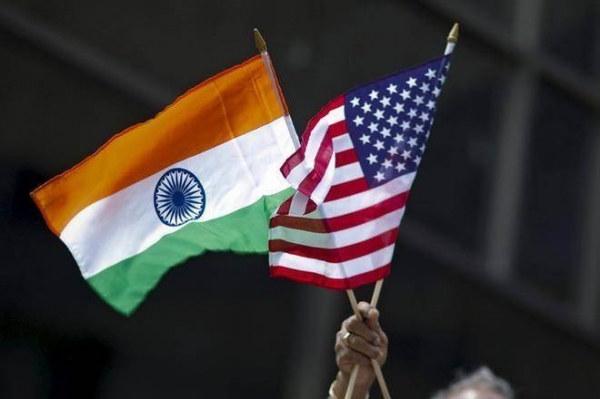U.S. remains India's top trading partner in 2019-20
The data also showed that China was India's number one trading partner from 2013-14 to 2017-18. Before China, the UAE was the largest trading nation. India is
- by B2B Desk 2020-10-09 06:06:07
The United States remained India's top trading partner for the second consecutive fiscal year in 2019-20, indicating an increase in economic ties between the two countries. According to data from the Commerce Department, in 2019-20, bilateral trade between the United States and India was $ 88.75 billion compared to $ 87.96 billion in 2018-19.
The United States is one of the few countries with which India has a trade surplus. The data trade gap between countries increased to $ 17.42 billion in 2019-20 from $ 16.86 billion in 2018-2019.
In the 2018-2019, the United States surpassed China for the first time to become India's top trading partner.
Bilateral trade between India and China decreased to $ 81.87 billion in 2019-20 from $ 87.08 billion in 2018-19. The trade deficit between the two neighbors decreased to $ 48.66 billion in 2019-20 from $ 53.57 billion in the previous fiscal.

The data also showed that China was India's number one trading partner from 2013-14 to 2017-18. Before China, the UAE was the largest trading nation.
India is also considering specific steps such as drafting technical regulations and quality control orders for a set of items with the aim of reducing dependence on imports from China and promoting local manufacturing.
Trade experts believe that the trend of expanding trade ties between New Delhi and Washington will continue in the coming years and that the two sides will participate in deepening economic ties.
Biswajit Dhar, a professor of economics at Jawaharlal Nehru University, said the presence of the Indian diaspora in the United States is one of the main reasons for the increase in bilateral trade.
"The presence of the Indian diaspora creates demand for Indian goods like consumer goods and we provide that. A balanced trade agreement that will further strengthen economic ties," Dhar said.
India and the United States are negotiating a limited trade agreement with the aim of resolving disputes on the trade front and strengthening trade ties.
Rakesh Mohan Joshi, a professor at the Indian Institute of Foreign Trade (IIFT), said that although the trade deal would be mutually beneficial for both countries, India should be a bit cautious when negotiating the deal with the United States in areas such as agriculture, dairy, and issues related intellectual property rights.
Subhash Chander Ralhan, president of the Ludhiana-based Hand Tools Association, said that there is huge potential to boost bilateral trade between the two countries due to the growing anti-China sentiment in both countries.
"Due to anti-China sentiment, many American companies are exploring news providers in countries like India to reduce dependence on China, and if that happens, it will greatly help India increase exports to the United States," Ralhan said.
India seeks to relax the United States visa regime, exemption from high duties imposed by the United States on certain steel and aluminum products, and increase market access for its products from sectors such as agriculture, automobile, automobile components, and engineering.
On the other hand, the United States wants greater market access for its farms and manufacturing products, dairy products, medical devices, and data localization, in addition to reducing import tariffs on some ICT products.
Also Read: Apple iPhone 11 set to retail at less than Rs 50,000 for the first time ever

POPULAR POSTS
Rupee Forecast 2025: Key Drivers Behind INR Weakness Against the US Dollar
by Shan, 2025-08-11 07:32:23
August 2025 IPO Preview: Big Listings from JSW Cement, NSDL, Knowledge Realty & SME Stars
by Shan, 2025-07-30 11:51:27
Ola Electric Q1 Results FY26: Revenue Falls 61%, Net Loss at ₹870 Cr - MoveOS 5 in FocusOla
by Shan, 2025-07-14 12:22:55
HAL, BEL & Data Patterns: 3 Defence Stocks Riding India's ₹50,000 Cr Export Ambition
by Shan, 2025-06-26 10:00:16
India GDP Forecast 2025-26 Raised to 6.5% by S&P: Key Drivers & Global Risks Explained
by Shan, 2025-06-26 10:30:46
Dalal Street Outlook: 5 Key Market Triggers to Watch This Week
by Shan, 2025-06-16 12:32:04
What is the Bond Market & How Does It Impact Your Investments?
by B2B Desk, 2025-02-05 09:42:55
RECENTLY PUBLISHED

Loan EMIs to Drop as RBI Slashes Repo Rate - Full MPC December 2025 Highlights
- by Shan, 2025-12-05 11:49:44

Pine Labs IPO 2025: Listing Date, Grey Market Premium, and Expert Outlook
- by Shan, 2025-11-05 09:57:07

The Agentic Revolution: Why Salesforce Is Betting Its Future on AI Agents
- by Shan, 2025-11-05 10:29:23

Top 10 Insurance Companies in India 2026: Life, Health, and General Insurance Leaders Explained
- by Shan, 2025-10-30 10:06:42

OpenAI Offers ChatGPT Go Free in India: What’s Behind This Big AI Giveaway?
- by Shan, 2025-10-28 12:19:11

Best Silver Investment Platforms for 2025: From CFDs to Digital Vaults Explained
- by Shan, 2025-10-23 12:22:46




 Subscribe now
Subscribe now 